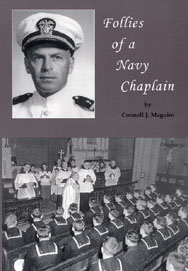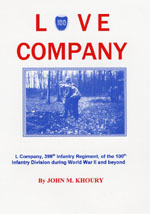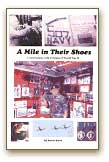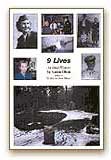Preface
When I first saw Arnold Brown, at a reunion of the 90th Infantry Division, he was carrying a scrapbook that said "Oberwampach" on the cover.
Places like Oberwampach don’t mean a lot to publishers of books about World War II. They want to hear of places such as Omaha Beach and Iwo Jima, whose very names will sell a lot of books. But Oberwampach – where Arnold Brown’s rifle company and two platoons of the 712th Tank Battalion, my father’s outfit, held off nine counterattacks over a three-day period – means a great deal to me, and it means even more to the men who fought there.
I knew Brown – who bears a striking resemblance to Colonel Sanders – was going to be one of my favorite interviews almost from the moment I asked him his name.
"Arnold L. Brown," he said.
"What does the ‘L’ stand for?"
"Lee."
"Was that after Robert E?"
"I don’t know of any ancestors named Lee, so it could have been."
After pausing, he added, "I hope the Arnold wasn’t after Benedict Arnold."
I also met Vern Schmidt at a reunion of the 90th Division. The 358th Infantry Regiment, which was part of the 90th, has a ritual which, perhaps, only people who have been in combat can fully appreciate: At the end of their annual lunch, which at that reunion in 1994 had nine or ten tables, the emcee would announce a table number, and table by table the veterans of the 358th rose and paraded past the podium, pausing to announce, "My name is So and So and I was wounded at Such and Such a place." Every now and then someone said, "I don’t know how they missed me, but I didn’t get a scratch," usually eliciting roars of laughter. But most of the seventy or eighty veterans who made their brief statements were wounded once, twice, and some of them several times. The 90th Division suffered the third highest rate of casualties of any division in the European Theater of Operations.
At the end of the procession, the emcee asked if anybody else would like to speak. That’s when Vern Schmidt came to the podium.
He said he’d like to tell a story, and apologized for the time it would take. The emcee assured him it was okay.
"On my trip to Germany in 1993, my wife and I visited a little home in the Siegfried Line where my squad had stayed for three days while holding a bridge over the Prum River," he said.
"We knocked on the door, and this couple came to the door. I said, ‘I was in this house in 1945,’ and the woman said, ‘You were an American soldier?’
"I said, ‘Yes.’ We came on in. They were overwhelmed that someone would come back and visit. And she said, ‘Can I tell you a brief story that took place, that you may not have put together?’
"She said, ‘When you came in’ – our squad had a big tall Texan as a captain; I can't remember his name, but it might have been Webster.
"When we’d go into a building we’d generally throw a grenade in to clear the place out until we knew it was safe. Somehow, this big tall Texan walked in, and he saw a cellar. He walked down to the cellar with his M-1, and it was dark. It was a square cellar. He shined his light, and there were 24 civilians sitting on the dirt floor and their eyes were wide, wondering, ‘What’s this guy going to do?’ And then he saw that on the wall opposite him was a crucifix. He said, ‘Are you Catholic?’
"And the lady who we met when we returned, her father said, ‘Ja, Ich bin Catolisch.’ And it was like it was a magic word. The GI dropped his rifle, he reached into his pocket, and he pulled out a rosary, and he said, ‘I'm Catholic, too.’ And for three days, the people in this cellar were taken care of. We gave them food, we took care of their wounds, and reminiscing back almost fifty years, this lady put her arms around us and hugged both my wife and myself, and said, ‘You know, doesn’t this do wonderful things in our life? It brings us together. Once we were enemies, and now we are friends.’ "
Jim Koerner and I have a ritual, too. He calls me very early in the morning once every few weeks and says, "Don’t you hate it when the phone wakes you up?"
I tell him he can call me anytime and I ask him how he is.
"Not bad for an old fart," he says.
If I don’t hear from him for a couple of months, I know he’s used up another of his nine lives. He only had two left at the end of the war, and has expended six or seven since.
When I went to take pictures for the cover of an audiobook I produced from our taped conversation a few years back, Koerner spread out some of his memorabilia on a coffee table. Among the items was a manuscript written on yellow legal paper. He said it was an account of his experiences that he wrote shortly after the war, while everything was fresh in his memory. It is much more detailed than the interview, and his comments are precious. In the manuscript, he changed the names of some of his officers. For this book, I have used mostly the memoir, with portions of the interview edited in.
I found Chuck Hurlbut through the Internet. He doesn’t own a computer, but his name was listed on a web site containing contacts for various veterans’ alumni groups, and I was looking for some information about an incident in the Battle of the Bulge involving the 299th Combat Engineer Battalion. I phoned him, and he gave me the name of a fellow engineer who could tell me more about the incident. We talked some more, and suddenly I realized that here I was on the phone with a veteran who had been on Omaha Beach on D-Day. He said Dan Rather interviewed him for a documentary; and I had seen the documentary, but it was four years earlier and I didn’t remember him specifically.
Halfway through my interview with Hurlbut, as he was describing the landing on Omaha Beach, I suddenly remembered the story he told Dan Rather, and I said, "Was that you?!" It was a story about a buddy of his, Tom Legacy of Niagara Falls, who wore a gaudy tie underneath his field jacket for the assault. Someone had sent him the tie from home, and although it was hardly regulation, he remarked, "What can they do, court-martial me?" and Chuck and Tom shared a good laugh.
Later that morning, after a raft full of explosives blew up behind him and he dragged a severely wounded buddy to safety, Hurlbut was in a state of near exhaustion and shock when he looked out from the dune line and surveyed the vision of Hell that was spread out before him. He saw someone staggering towards him 60 or 70 yards away, his jacket in shreds, half his face torn off, and yet there was something about him that made Hurlbut think, "I know that guy." And then he saw the tie.
When I launched the World War II Oral History web site, my goal was to publicize a pair of books I had written, but soon the site took on a life of its own. A high school student in Arkansas sent me an e-mail asking if there was a veteran he could interview on line. I sent him the e-mail address of a B-17 crew member who had contributed a couple of stories to the site. In 1998, Patsy Giacchi of Clifton, N.J., asked his daughter to do a web search on "that ship" he was on. She found my interview with Angelo Crapanzano, a survivor of LST 507, which was sunk during the ill-fated Exercise Tiger. It turns out the two veterans live in neighboring counties, and the web site brought them together.
"When are you going to interview some women about the war?" Helen Grottola asked me several years back.
"How about now?" I replied.
I still haven’t transcribed my interview with Helen, whose late husband, Joe, was one of the 712th Tank Battalion’s postwar chaplains, but she heightened my awareness that World War II was waged not just by men. At a Florida mini-reunion of the 712th a few years back, I interviewed Jeannie Roland, whose late husband, Jack, had been a sergeant in the battalion’s Headquarters Company. Her story is included in this book, as is a narrative drawn from my interview with Kay Brainard Hutchins, who joined the Red Cross while two of her brothers were missing in action.
One of those brothers, 2nd Lt. Newell Brainard, survived one of the most spectacular aerial battles of World War II only to be murdered on the ground by slave labor camp guards, who later were executed for war crimes.
The Kassel mission bombing raid in which Kay Hutchins’ brother took part is one of the great little-known stories of World War II. There are brief references to it in a number of books, often with slight inaccuracies. What is most often noted about the battle is that on Sept. 27, 1944, the 445th Bomb Group of the 2nd Air Division sustained the heaviest one-day losses of any bomb group in 8th Air Force history.
I learned of the Kassel mission while researching the life of Lt. Edward L. Forrest, an officer my father knew briefly during the war. Ed Forrest had nothing to do with the Kassel raid, other than the fact that he was killed in the village of Heimboldshausen, Germany, on April 3, 1945, and Heimboldshausen is only about 20 kilometers from Friedlos, where Walter Hassenpflug lives. I met Hassenpflug on my trip to Heimboldshausen in 1996, and after helping me with my own research, he took me to the Kassel Mission Memorial, in a clearing in the Hesse State Forest.
It was a cold February afternoon, and there was a dusting of snow on the ground. A fading bouquet of dried flowers rested in front of one of the three stone slabs, on which were inscribed the names of 118 Americans and 23 Germans who died in or as a result of the battle.
Frank Bertram and George Collar survived the Kassel mission, in which 35 B-24 Liberators strayed off course and were ambushed by as many as 150 German fighter planes. Both bailed out of their planes and became prisoners of war.
All Kay Hutchins knew until 1986 – and all her mother ever knew – was that Newell Brainard was missing in action, and that he was later reclassified as killed in action. When Kay’s mother died, Kay discovered a newspaper clipping from Sept. 28, 1944, in her desk drawer. The article was about the bombing raids of the day before, in which more than 2,000 planes hit various targets in Europe. It was the only clipping from the war in the desk, and Kay believes her mother must have had some sort of extra-sensory perception.
When Patsy Giacchi bobbed up in the English Channel following the torpedoing of LST 507, he looked up at a gun turret where only moments before he had seen the body of a dead sailor. Suddenly he saw his mother saying to him in Sicilian, "Patsy, save yourself!"
Arnold Brown, after describing several harrowing incidents in which he escaped death by what often seemed a miracle, says: "And then I had my vision."
Jim Koerner, George Collar and Frank Bertram are all former prisoners of war. Collar, Bertram and Hutchins are all connected to the Kassel mission. Giacchi is a survivor of Exercise Tiger, which, like the Kassel mission, has been denied its place in history because it was an incident that never should have happened. Arnold Brown and Vern Schmidt were both in the 90th Division. Brown and Hutchins both had educations that were cut short by the Depression. Although the stories in this book will seem disparate at times, there are many threads that tie them together.
When I began interviewing World War II veterans, I described my avocation as being "like oral history." Then one day a friend said, "It isn’t like oral history. It is oral history."
Although the stories I have preserved represent a tiny but important piece of the lore of World War II, it was not out of any sense of history that I recorded them, but rather because I found them simply to be great stories, stories that touch upon every aspect of the human condition.
![]() Contents
Chapter
1, Arnold Brown
Contents
Chapter
1, Arnold Brown![]()







